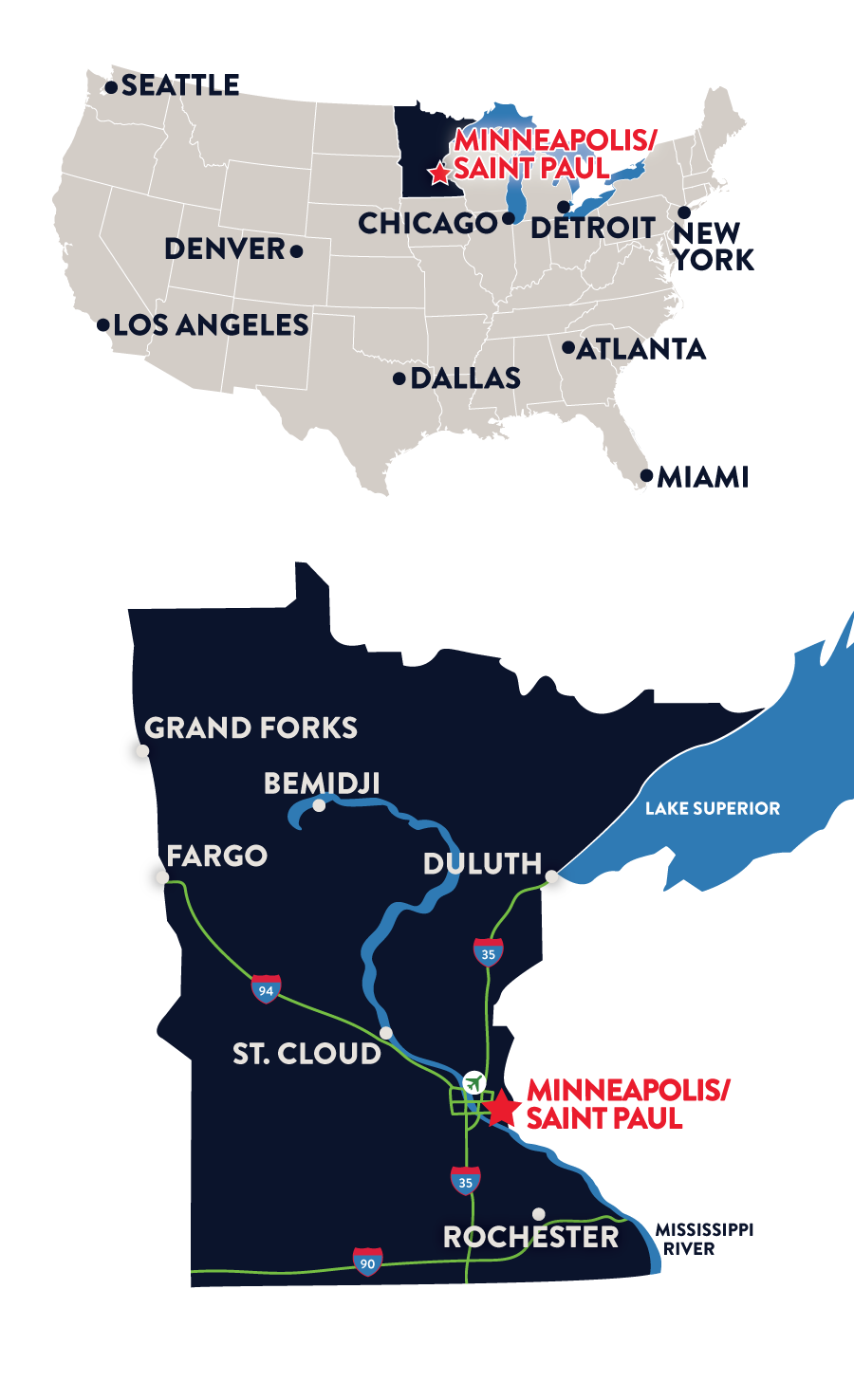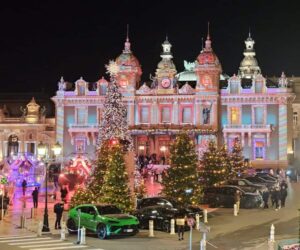Facts & Figures
Andrew.Parks
Wed, 09/18/2024 – 16:41


State Name
The name “Minnesota” comes from Dakota Indian words meaning “sky-tinted waters” or “sky-blue waters.”
- Capital: St. Paul
- Statehood: Became a state in 1858, the 32nd state in the union
- Size: 12th-largest state in U.S.
- Length: just over 400 miles
- Width: varies from about 200-350 miles
- Location: Upper Midwest, in north central U.S. Along the U.S.-Canada border
Population
- Total: 5.5 million
- State rank: 21st
- Minneapolis-St. Paul metropolitan area: 3.5 million, 16th-largest metro area in the U.S.

Kayaking on Bde Maka Ska at sunset
/ Mike Krivit Photography, courtesy Meet Minneapolis

Ride the Green Line light rail between downtown Minneapolis and St. Paul, and many neighborhoods in between
/ Robert Ferdinandt

Mall of America in Bloomington

Thursdays Downtown transforms downtown Rochester into an all-day block party / AB-Photography.US

Take the North Shore Scenic Railroad out of Duluth on the Lake Superior waterfront
/ Visit Duluth
Five Largest Cities
- Minneapolis, largest city in Minnesota: 412,517
- St. Paul, state capital: 300,353
- Rochester, home of Mayo Clinic: 111,907
- Bloomington, home of Mall of America: 87,224
- Duluth, major shipping port on Lake Superior: 86,597
Minnesota Waters
Minnesota’s lakes and rivers are part of what this state is all about. One of Minnesota’s nicknames is “Land of 10,000 Lakes,” but it really has lots more. It’s on the shore of the biggest of the Great Lakes, Lake Superior. And, it’s where the world’s third-largest river, the Mississippi, begins.
Here are some facts about Minnesota’s waters:
- Number of lakes: 11,842 (over 10 acres)
- Rivers and streams add up to 69,200 miles
- Mississippi River: 680 miles of its 2,552 total miles flow through Minnesota.
- Lake Superior is the world’s largest freshwater lake. It’s at the end of the St. Lawrence Seaway, which brings boats from around the world to the port of Duluth, Minn.
- Minnesota’s rivers and streams flow in three directions: north to Hudson Bay in Canada, east to the Atlantic Ocean, and south to the Gulf of Mexico.
Economy
Tourism: $16 billion industry in Minnesota
2020 Tourism and the Economy Fact Sheet, featuring 2018 state sales tax and jobs data
Other major industries: healthcare and medical equipment, high technology, finance and insurance, forest products, printing and publishing, food products, iron ore mining
Minnesota businesses: Minnesota is home to some of the biggest companies in the U.S., including Target, Best Buy, 3M, General Mills, Medtronic, Hormel Foods, Ameriprise Financial, Ecolab and St. Jude Medical.
Agriculture: Top crops include corn, soybeans, sugar beets, wheat. Major livestock includes hogs, dairy cows, beef cattle, turkeys.
Climate
Twin Cities average temperatures: High – Low
- January: 24°F / 7°F (-4.4°C / -13.9°C)
- May: 70°F / 48°F (21.1°C / 8.9°C)
- August: 80°F / 61°F (26.7°C / 16.1°C)
- October: 59°F / 39°F (15°C / -16.1°C)
Average annual snowfall: 36-70 inches (91-178 cm)
Normal annual precipitation: 18-32 inches (46-81 cm)
Temperatures are usually slightly warmer south of the Twin Cities, and cooler in northern parts of the state.

Minnesota’s state bird is the loon
/ Allie Hoeft
State Symbols
- State Motto: “L’Etoile du Nord,” which means “Star of the North” in French
- State Nicknames: North Star State, Land of 10,000 Lakes, Gopher State
- State Bird: Common Loon
There are more loons in Minnesota than in any other state except Alaska. - State Flower: Pink and White Lady’s Slipper
The flower looks like a moccasin, or slipper, and grows in damp, wooded areas. - State Fish: Walleye
Found in lakes throughout Minnesota, the walleye is a favorite among anglers. - State Tree: Red Pine (also called Norway pine)
- State Gemstone: Lake Superior Agate
Famous Minnesotans
- Ann Bancroft, explorer: first woman to cross the ice to both the North Pole (1986 by dogsled) and South Pole (1993 by skis)
- Bob Dylan, singer/songwriter: Rock & Roll Hall of Fame; Grammy, Oscar and Nobel Prize winner
- Louise Erdrich, author: numerous novels, poetry, short stories and more
- Judy Garland, actress/singer: played Dorothy in the movie “The Wizard of Oz”
- Hubert H. Humphrey, U.S. Senator, 1949-64 and 1971-78; U.S. Vice President, 1965-69
- Garrison Keillor, author/humorist/radio personality: host of “A Prairie Home Companion”
- Charles A. Lindbergh Jr., first person to fly alone over the Atlantic Ocean, 1927
- Walter F. Mondale, U.S. Senator, 1964-76; U.S. Vice President, 1977-81
- Karen Nyberg, astronaut: 2008 space shuttle flight
- Prince (Rogers Nelson), singer/songwriter/actor: Grammy Award winner, Oscar for Best Soundtrack; known for his movie “Purple Rain”
- Charles Schulz, cartoonist: created Peanuts series
- Lindsey Vonn, only American woman to win gold in downhill skiing (2010)
- Laura Ingalls Wilder, author: “Little House on the Prairie” series of children’s books
- Roy Wilkins, civil rights leader: director of the NAACP, 1955-1977
Fun Facts
- Minnesota is the birthplace of great inventions like the Post-it-note, rollerblades, and waterskiing, among other inventions
- Mall of America in Bloomington is big enough to hold 32 Boeing 747 airplanes.
- More gray wolves live in Minnesota than in any other of the Lower 48 states.
- There are 69,200 miles of rivers and streams in Minnesota. That’s enough to circle the equator 2 ¾ times!
- The Los Angeles Lakers basketball team are called the “Lakers” because they were originally from Minnesota – the land of lakes!
- Minnesota has more bike trails than any other state in the country.
- On average, Minnesota has one recreational boat per every six state residents.
Topic
Line illustration
1
all-other
0
Short







